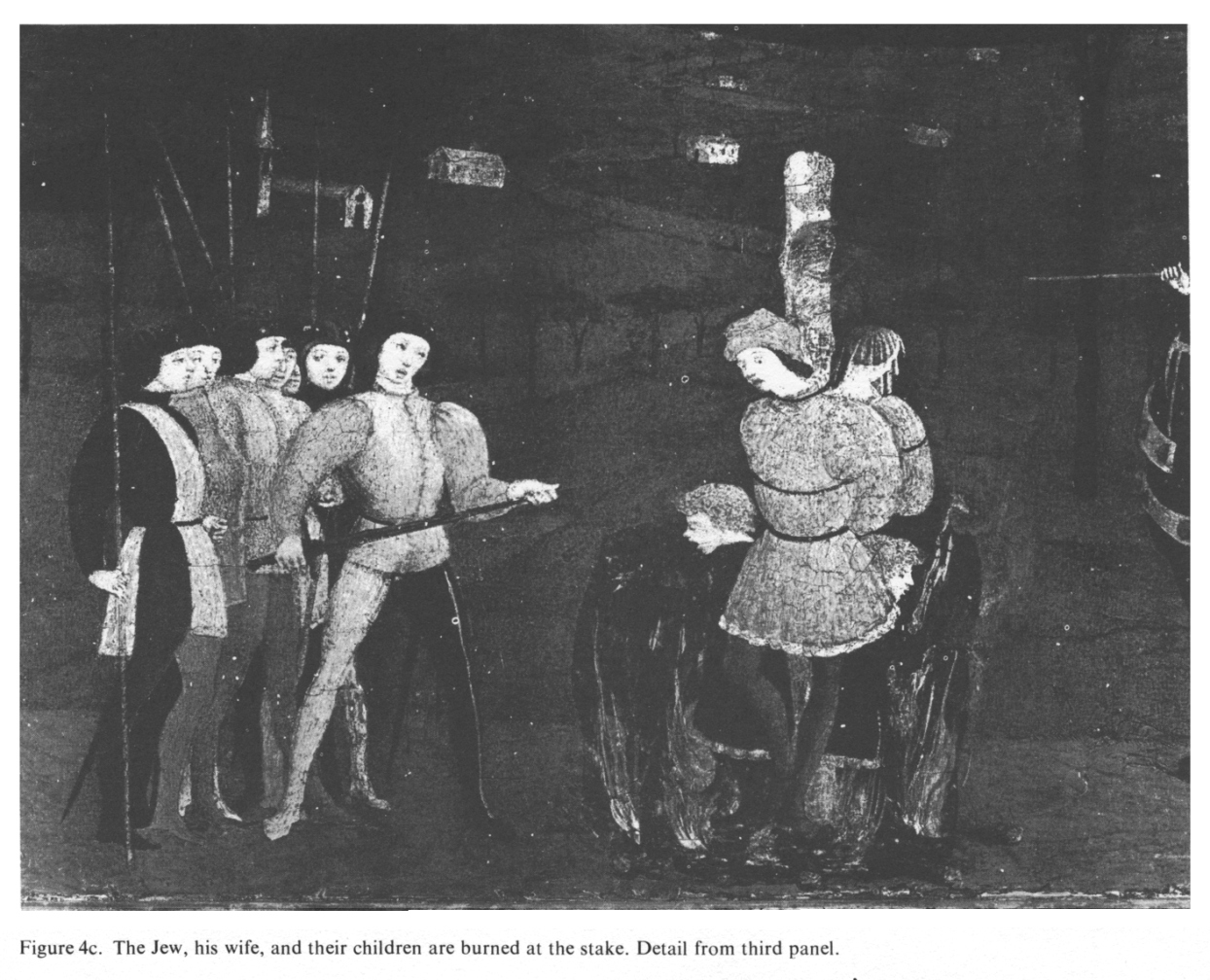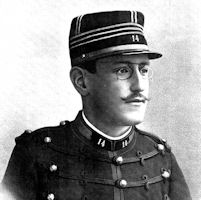![]()
By Toni L. Kamins
European anti-Semitism is integral to European culture.
Beginnings
Born with the rise of Christianity and Roman Catholicism, anti-Jewish sentiment is an old and firmly entrenched phenomenon in Europe. Of course Jew-hatred was not invented by Christianity, it existed in pre-Christian and pagan times, but in Europe it took Christianity to institutionalize it, codify it and create what became a essential force in European history in general and European Jewish history in particular.
Although the seeds of Anti-Judaism were sewn along with the Roman Empire’s embrace of Christianity as its official religion in 321 AD, popular Jew-hatred dates back to the Middle Ages. The early Church leaders of the Roman Empire expanded upon various anti-Jewish charges enumerated in the Gospels i.e. responsibility for the crucifixion and rejection of the deity of Jesus, and by the third and fourth centuries early bishops such as John Chrysostom were charging Jews as a group with all manner of evil and degenerate behavior. Indeed the very existence of Jews as a distinct community living and prospering throughout Europe was seen by Christian clerics as a basic challenge to Christian theology and the concept of the Church as the True Israel.
By the fifth century, laws limiting Jewish legal rights, participation in commerce and government, and the prohibition of certain social contacts (Jewish relations with Christian women were punishable by death) were widespread, but not yet widely enforced.

European anti-Semitism. Anti-Semitism, vol. 3, col. 105-106: The Jew, his wife, and their children are burned at the "Christian" stake. Detail from third panel. From: Anti-Semitism; In: Encyclopaedia Judaica 1971, vol. 3.
The Middle Ages
The Crusades of the 11th, 12th and 13th centuries proved to be a watershed for European Jew-hatred. When the Crusaders set out for Jerusalem to free it from the Turks their roads through Germany and France were littered with the corpses of the descendents of the alleged killers of Jesus — local Jewish residents. In Rouen, Orleans, Limoges and Mainz Jews were portrayed as forces of the anti-Christ and summarily murdered. Oftentimes given the choice of conversion to Christianity or death, many Jews committed suicide rather than submit to forced conversion.
From the beginning of the Crusades onward Jewish civic life in Europe was severely restricted and Jews subject to greater and greater acts of violence and murder. It is in this period that we see the rise of many of the trumped-up stories that were to characterize Jew-hatred and anti-Jewish violence for centuries through to the present day — the blood libel, lies about a Jewish conspiracy to take over the world, fabrications that Jews desecrate the Host and carry diseases etc. Indeed anecdotes of the Host coming to life when set upon by a Jew were in wide circulation. Many of these were spread by the Fourth Lateran Council (1215), which also established the rules that required Jews to wear distinctive marks or clothing.
The Middle Ages was also a time when rabbis were forced to take part in religious disputations with Catholic clergy to defend Jewish religious texts, such as the Talmud. A verdict of guilty against the Jewish texts was always a given and often resulted in the burning of the books.
Money lending
The Church forbade Catholics to lend money at high rates of interest — usury — but it did permit Jews to engage in it. Before the Middle Ages all professions, commerce and agriculture, were open to Jews, but by the end of the Crusades lending money was one of the very few occupations the Church permitted them. This coincided with the rise of the importance of credit in the European economy, and it was to become a major source of friction between Jews and non-Jews because anyone who needed to borrow money would be forced to deal with Jewish moneylenders. But Jews were far from the only moneylenders, and in fact they were not even the largest group in the business. That distinction belonged to the bankers of Florence, Sienna and Lombardy. To make matters worse, when those same bankers gained hegemony over international credit, many of Europe’s crowned heads seized Jewish property and expelled their Jewish communities because they no longer needed them to finance royal projects. In many cases, France for example, the Crown would expel the Jews of the kingdom repeatedly and then invite them back so it could tax them and use the proceeds. All manner of special Jew taxes were on the books throughout Europe.
The Reformation
The Reformation proved to be good news and bad news for the Jews of Europe. Jews in countries that remained Catholic were subjected to the same (and worse) anti-Jewish measures as they were before. In Italy and Germany ghettos were established. But some of the new Protestants (i.e. Calvinism) were more lenient toward Jews and Judaism. Some countries, such as the Netherlands, became havens for Jews and would become particularly important during the Spanish Inquisition when Jews were forced to either convert or burn.
The Enlightenment
Segregation of Jews started to decline in the 18th century when many European intellectuals began to question the orthodoxies of the Catholic and Protestant religious establishments. Secularism and justice were the popular slogans, and philosophers like Montesquieu and Jean-Jacques Rousseau viewed Jews as oppressed people and came to their defense. In 1714, the Englishman John Toland recommended freeing Jews from the restrictions under which they were forced to live. But it wasn’t until 1791 that France became the first European country to remove many of the limitations.
Napoleon Bonaparte became the Jews’ unlikely champion. Bonaparte hated Jewish practice and theology, but his quest for empire made him determined to bring them into the French mainstream. In 1806 he convened an Assembly of Jewish Notables, the sole purpose of which was to make sure there was nothing about Jewish law that was inherently incompatible with French civil law. There wasn’t and soon the physical and legal barriers to Jewish civil rights were falling throughout Europe.
Modern Anti-Semitism
Though anti-Jewish sentiment was far from gone, most legal impediments to civil rights for Jews had been dismantled by the middle of the 19th century. But some, like the More Judaico, the Jewish Oath, remained. The only purpose of this bizarre oath, used during legal disputes between Christians and Jews, was to demonstrate that Jews were untrustworthy. It was common from the Middle Ages through the 18th century, but was still used in France until the mid-19th, and in other countries into the 20th. The oath’s wording and administration took different forms in different countries, but usually it involved forcing the Jew to stand on a pig’s skin and recite gibberish that included vague references to the Old Testament.
In England, the thrice-elected Baron Lionel de Rothschild could not take his seat in the House of Commons because members of the House were required to swear on “the true faith of a Christian,” something to which a Jew could not swear. Many attempts to amend the law failed, but after having been elected for the first time in 1847, Rothschild was finally able to take his seat in 1858.
Jewish Civil Rights: A Double-Edged Sword
Jewish civil rights made the ghettos, occupational restrictions and identifiable clothing obsolete. It also changed the nature of Jew-hatred. As long as Jews could be easily recognized either by where they lived, their occupation or their dress, in addition to their religion, Jew-hatred was mostly confined to religion. But at the same time as the average Jew’s life was becoming more mainstream, and Jews became physically indistinguishable from Christians, Jew-hatred developed into social and political mistrust, and Jews were charged with contaminating French, German or English life or the German nation etc.
Racial theories, in which Jews were cast as polluters of the pure European races, were promulgated by pseudo-philosophers such as Joseph Arthur, Comte de Gobineau (“An Essay on the Inequality of the Human Races”), Edmond Picard, Houston Stewart Chamberlain (“Die Grundlagen des neunzehnten Jahrhunderts” — The Foundations of the Nineteenth Century) and the composer Richard Wagner. These went on to form the basis for Nazism. It has been said by many that it was a very short walk (in terms of years) from open ghetto gates to the gas chambers.
The 19th century also gave us the term anti-Semitism.
Wilhelm Marr (1819-1904) was a vicious Jew hater. His most famous work “Der Sieg des Judenthums über das Germanenthum von nicht Confessionellen Standpunkt” (“The Victory of Judaism over Germandom: From a Non-Denominational Point of View”) laid the groundwork for his League of Anti-Semites. “Semitism,” according to Marr, was the replacement of German values, ways and sensibilities with Jewish ones. Therefore anyone who opposed “Semitism” was an anti-Semite. Today the word is used as a catchall for Jew-hatred.

Alfred Drefus, French-Jewish artillery officer (9 October 1859 – 12 July 1935). His trial and conviction in 1894 on charges of treason, the Dreyfus Affair, became one of the best known examples of modern European anti-Semitism. The incident eventually ended with Dreyfus's complete exoneration.
The Dreyfus Affair
On October 15, 1894, Alfred Dreyfus, a (Jewish) captain on the French army general staff, was accused of selling artillery secrets to the Germans and arrested for treason. The so-called evidence against him had been forged by anti-Jewish officers who manipulated the anti-German paranoia of the French army and fabricated a case against the one staff member against whom they could get away with making the scapegoat — the Jew. The real spy was Major Ferdinand Walsin-Esterhazy. High-ranking army general officers colluded with many in the government including Minister of War, General Auguste Mercier, to create a conspiracy so insidious and so deep that the fallout from it ripped France asunder and threatened to bring down the Republic itself. Dreyfus spent several hellish years in prison on Devil’s Island, but was eventually exonerated and restored to military rank. To this day there are those in France who believe Dreyfus was guilty of treason and the whole affair was a Jewish conspiracy.
The Holocaust
So much has been written about the Holocaust that it is not necessary to go into any detail here except to say that without Europe’s long and pervasive history of Jew-hatred the Holocaust would not have occurred.
Jew Hatred Today
Optimists and people of good will imagined that the gruesome and shameful crimes committed against European Jews by many European Christians between 1939 and 1945 would have put an end to Jew-hatred, or anti-Semitism or whatever name you want to assign this proclivity. It didn’t. It’s alive and well in 2012 and although many have taken to calling it the new anti-Semitism, it’s the same old rant, albeit with some updated slogans.
In the decades immediately following World War II it was considered unseemly to make anti-Jewish remarks in public. Now that the generation of Holocaust victims and victimizers is dying, the Jew-hatred business is returning to normal. It would be easy to blame Europe’s Muslims, but that would be a mistake. Although we can say with some satisfaction that many European Christians have finally learned what hatred in the name of religion can lead to, many still have not. Just this week the extremist Jobbik party in Hungary, with 47 seats in parliament, stated that Jews are “invading” Hungary. And a just-released German-government study revealed that one in five mainstream Germans have anti-Jewish attitudes.
We are left to wonder what more it will take, and left to fear the response.
Toni L. Kamins is a writer and editor in New York. She is the author of the Complete Jewish Guide to France, the Complete Jewish Guide to Britain and Ireland (St. Martin’s Press) and the forthcoming Complete Jewish Guide to Paris. Her work has appeared in the New York Times, the New York Daily News, Tablet, Bonjour Paris, the Jerusalem Post, the Forward, New York Magazine and other places. Her personal website is at tonikamins.com.
© CrethiPlethi.com, 2012. This article may be reprinted (in full length) as long as information is provided about its author, date, place of publication, and original URL.



 RSS
RSS












A Very Brief History of European Christian Anti-Jewish Sentiment http://t.co/YtEY8Ivo
Brief, compelling, and unfortunately timely history of Euro #antiSemitism by @ToniKamins . http://t.co/lPcDUvaS
Tragic but true“@HaroldItz: Brief, compelling, and unfortunately timely history of Euro #antiSemitism by @ToniKamins . http://t.co/IQzMqIuT”
[…] PS: zie ook https://www.crethiplethi.com/a-very-brief-history-of-european-christian-anti-jewish-sentiment/the-hol… […]
A Very Brief History.
http://t.co/veusPBP5
A Very Brief History of European Christian Anti-Jewish Sentiment http://t.co/YtEY8Ivo
A brief history of #Christian #antisemitism in Europe. http://t.co/Sd0KBvFx #Jew
A brief history of #Christian #antisemitism in Europe. http://t.co/Sd0KBvFx #Jew
A Very Brief History of European Christian Anti-Jewish Sentiment http://t.co/3owsXum3
A Very Brief History of European Christian Anti-Jewish Sentiment http://t.co/AB7zNllV
A Very Brief History of European Christian Anti-Jewish Sentiment http://t.co/OwH2bq4b
[…] Read together with “A Very Brief History of European Christian Anti-Jewish Sentiment.” […]